Cheaters Simple Yellow Curry Recipe + Guide To Make Your Own
This recipe is the essence of work smarter, not harder. Can’t find shrimp paste or galangal at your local supermarket? Don’t know what galangal is? That’s okay, this recipe will create a yellow curry that tastes great but is also customisable to what you have on hand. It’s ideal for meal prep as it freezes well and lasts 5 days in the fridge.
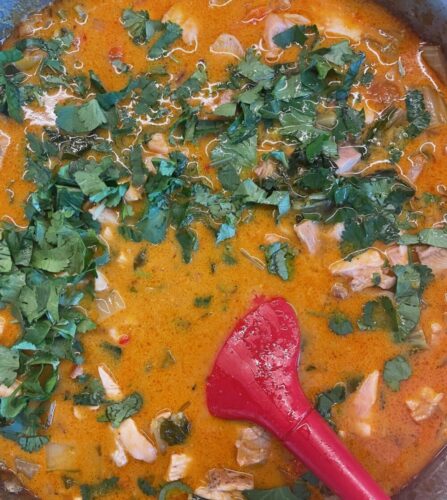
Why I Made This Recipe And Guide
Simply, I couldn’t find shrimp paste, galangal or turmeric at my local supermarket. These are traditional ingredients normally found in Thai curries, often only found at Asian supermarkets. If I’ve done this correctly, this recipe should act like a guide for creating an EastAsian-ish style yellow curry with what you have in your fridge/freezer and save someone the trip to multiple supermarkets.
Tip: It’s important to change no more than 3 or 4 things until you understand what every change you make will do from a culinary perspective. Understanding ingredients is a skill that must be practiced.

Ingredients
People tend to be afraid to change recipes but thoughtful changes can make a recipe much better. It’s okay to use my recipe as a base for changes that suit your family or tastes better.

Protein
My recipe uses chicken thighs because my partner and I are trying to lose weight and chicken just makes sense for us. Tip: I cook the chicken in big pieces because it’s easier to not overcook the chicken that way. It’s also easier to slice cooked chicken over raw chicken.
The following are suggestions on changing you protein base of this meal to suit you.
Beef – such as chuck or another stew meat will work well. I’d add in some carrots or potatoes to make this a very hearty curry. Changing the protein to beef is going to make the curry richer and add more of an umami depth. I would lean into the richer quality and add things like tomato paste or a little chicken stock over my fish stock powder + water.
Fish – like rockling, halibut or any firm strong fleshed fish. You don’t want anything delicate that will overcook or break easily in the curry. Using fish instead of chicken would create a lighter curry with a more delicate taste. Additions like bamboo shoots or Thai Basil would go nicely.
Prawns (Shrimp) – A sweet flavourful addition to any curry. Additions like tamarind paste and sugar would bring out the sweet quality prawns have.
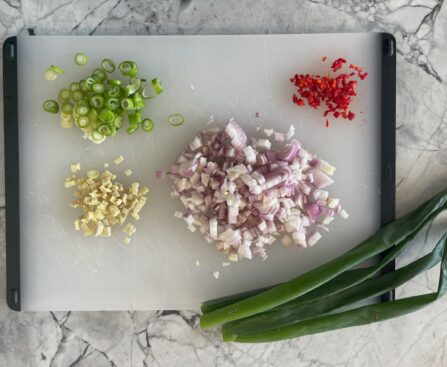
Aromatics
The flavour based of this curry comes from shallots, spring onions, ginger, garlic, lemongrass paste and chillies.You could edit this base if you have need, but I would one change only as much as you have to because these ingredients are the foundation of the curry. If you do need to swap them, swapping them for something from the same family makes the most sense.
Shallots and Spring Onions – are part of the onion family and can be swapped for other onions like a brown or yellow onion in a pinch.
Ginger and Garlic – If you have no fresh ginger or garlic then minced garlic or ginger from a jar or packet will work. As a last resort you could use powdered spices. If you can’t use ginger at all then turmeric is a good switch. A switch for garlic could be garlic chives or to use more shallots in the recipe.
Chillies – Many people have no tolerance for spice and choose to avoid them, if this is you just don’t use any chillies. However if you do this you will miss out on the flavours chillies bring to dishes. Instead you can combat spice by adding more sweet flavours like sugar or by adding cream like more coconut milk or using coconut cream. Sweet and cream of any kind tend to kill spicy flavours off and a stomach that is sensitive to spice may not even notice it’s there.
Lemongrass Paste – is often used in SouthEast Asian cuisines like Thai or Vietnamese food. It has a citrus floral smell and with an almost tangy lemony taste. Substituting lemongrass for a lemon is not an exact match but is an option.
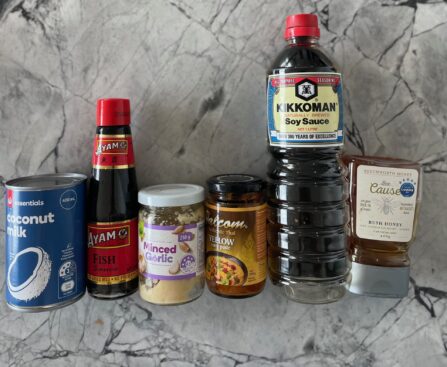
Liquid Bases
This recipe uses fish sauce, soy sauce, honey, coconut milk, water and fish stock powder. These are all in my opinion cheap and essential ingredients. They last a long time and are worth investing in but if you need to swap them for whatever reason, my suggestions are below.
Fish Sauce – does not taste like fish in your curry. This adds so much depth to a curry I would avoid removing it if possible.
Soy Sauce – This also adds a lot of depth to your curry, but it can be substituted with tamari or coconut amino acids for a similar effect.
Honey – can easily be substituted for other kinds of sugar.
Coconut Milk – can be substituted for coconut cream, this will make it a thicker creamier curry.
Fish stock Powder + Water – This is a light tasting addition to your curry but it can be switched with chicken stock for a richer flavour or vegetable stock for a soft taste.
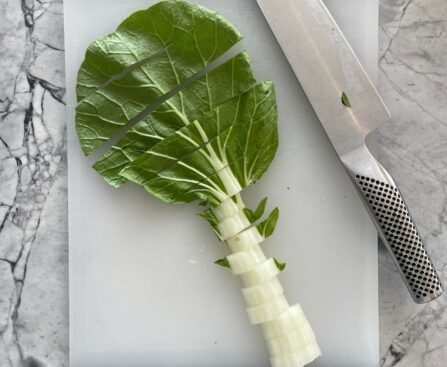
Extra Substitutions, Additions And Everything Else
Vegetables – Capsicums and bok choy are what I had available but things like baby corn, carrots, spinach, bamboo shoots, and daikon would go well. Adding things like potatoes or sweet potatoes will create a heartier and thicker curry.
Additions that will add more depth of flavour – shrimp paste (salty), tomato paste (sweet and acidic), tamarind paste (sweet and sour), galangal (peppery) etc
What is Galangal? It is a member of the ginger family but it tastes a little more peppery and citrusy than ginger. It has a unique earthy taste. It’s worth trying if you ever find it!
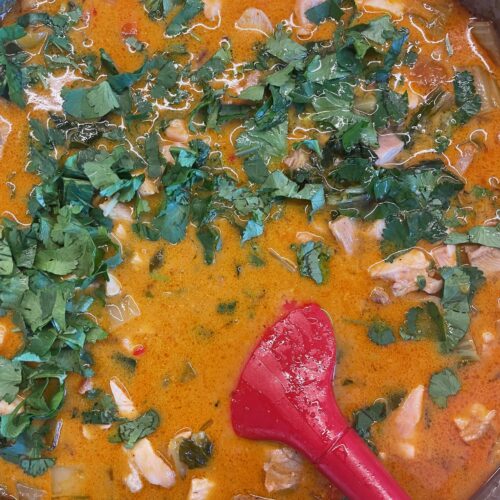
Cheaters Simple Yellow Curry
Ingredients
- 600 g Chicken Thigh Fillet Skinless
- 2 Shallots chopped finely
- 20 g Ginger chopped finely
- 30 g Garlic minced
- 3 Birdseye Chillies finely chopped
- 30 g Fish Sauce
- 30 g Soy Sauce
- 15 g Honey
- 50 g Lemongrass paste
- 70 g Yellow Curry Paste
- 200 ml coconut milk
- 100 ml Water
- 5 g Fish Stock Powder
- 1 Bok Choy roughly chopped
- 1 Green Capsicum roughly chopped
- 1 Red Capsicum roughly chopped
- 1 Lime Juice
- 2 sprigs Spring Onion Separate the white part from the green, but slice both parts into thin rounds.
- 1 handful coriander leaves for seasoning
Instructions
- Season your chicken with salt and pepper on both sides.
- Pan fry on medium heat the whole chicken thighs on both sides until cooked through. Be careful not to over cook the chicken, take it off the heat when you can easily pierce it with a knife or temperature reads 73 degrees celsius. Set aside.
- In the same pan you cooked the chicken, add another 15g or 1 tablespoon of oil. Once hot add in the white part of the spring onion, ginger, garlic. Cook until slightly softened.
- Add in capsicums and buk choy, cook for 1 minute. Then add curry paste.
- Stir and move the curry paste around the pan, coating the vegetables for 30 seconds.
- Add in coconut milk, water, fish sauce, soy sauce, Birdseye chillies, honey and fish stock powder.
- Turn down the heat to low and let simmer for 3 minutes. During this time chop your chicken into small bite size pieces, saving any juice that comes from the chicken thighs.
- Add your chicken and juices to your curry. Let simmer for 30 seconds.
- Just before you eat your curry add in your coriander and lime juice.
- Serve over rice, coconut rice recommended.
